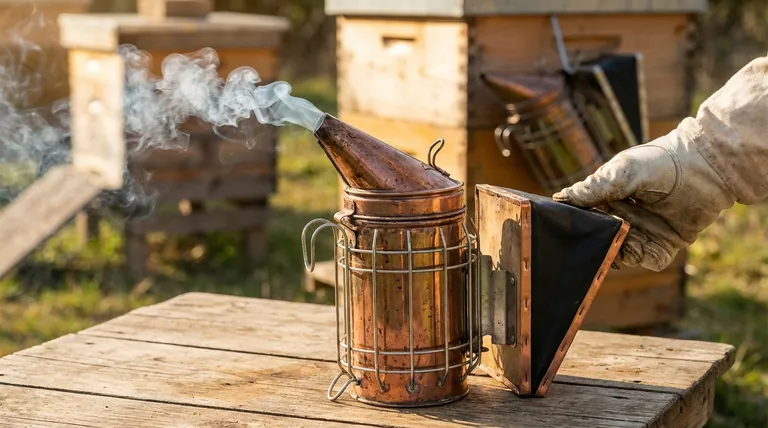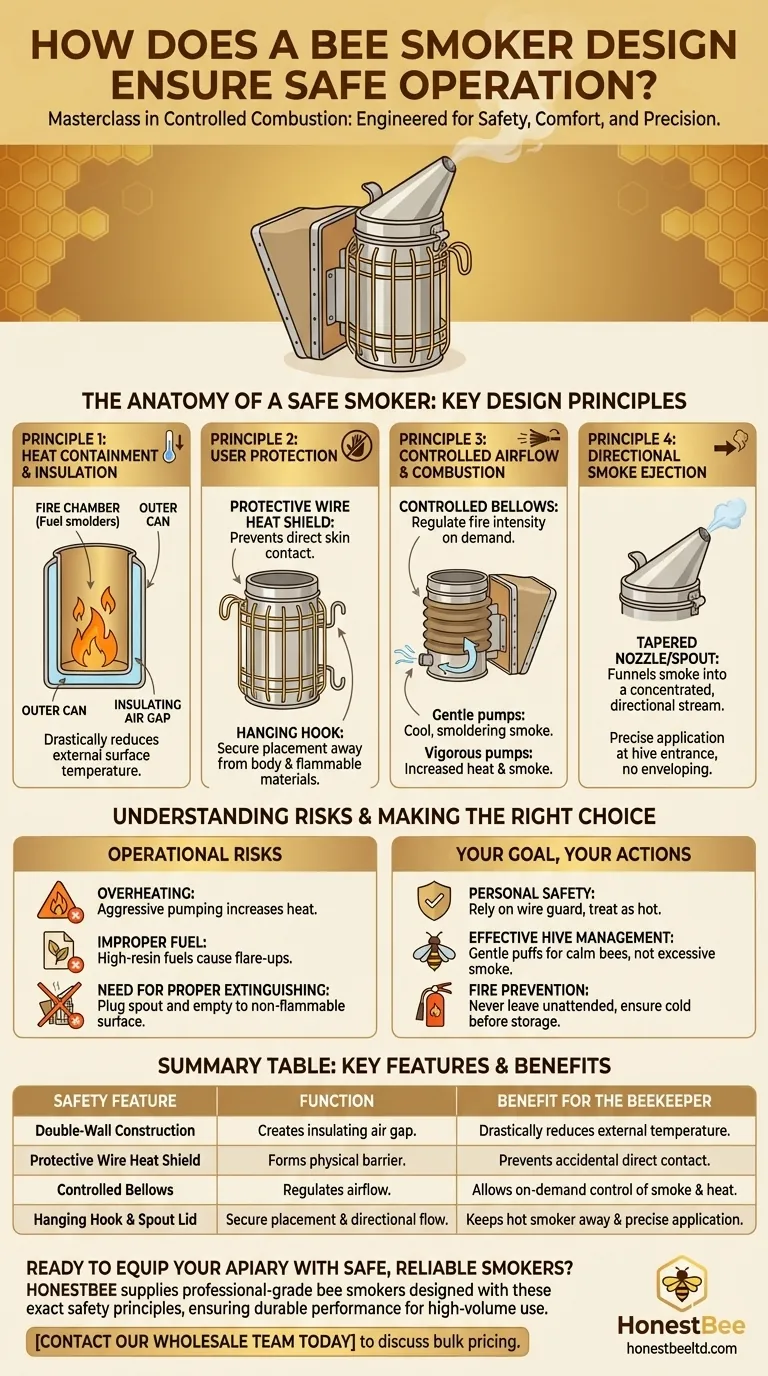At its core, a bee smoker's design is a masterclass in controlled combustion. Its safety is not accidental but is engineered through specific features that manage extreme heat, protect the user from burns, and provide precise control over the smoke output. The primary safety mechanisms are a protective wire heat shield, a double-walled chamber for insulation, and bellows that regulate the fire's intensity.
The safety of a bee smoker is achieved by systematically separating the user from the heat source while granting them direct control over the combustion process. Each component is designed not just for function, but to create a predictable and safe barrier between the beekeeper and the fire within.

The Anatomy of a Safe Smoker: Key Design Principles
A bee smoker appears simple, but its design incorporates several overlapping principles to ensure it can be operated safely, even when containing smoldering fuel at several hundred degrees.
Principle 1: Heat Containment and Insulation
The most critical safety feature is the double-wall construction. The smoker contains an inner can, often called the fire chamber or burner, where the fuel smolders.
This chamber is surrounded by a second, outer can. The air gap between these two walls acts as a highly effective insulator, dramatically reducing the temperature of the external surface you might accidentally touch.
Principle 2: User Protection from Direct Contact
To prevent burns, a protective wire frame or heat shield encases the entire combustion chamber. This grid creates a physical barrier, ensuring you cannot make direct skin contact with the hot metal surface of the smoker's body.
Additionally, most smokers include a small hook on the side. This simple feature is crucial for safety, allowing you to hang the hot device on the side of a hive box or a dedicated carrier, keeping it securely away from your body and flammable materials when not in use.
Principle 3: Controlled Airflow and Combustion
The attached bellows are the primary control mechanism for the smoker. Pumping the bellows forces a jet of fresh air through a nozzle at the base of the fire chamber.
This injection of oxygen is what controls the rate of combustion. Gentle, infrequent pumps maintain a cool, smoldering smoke. Vigorous pumping stokes the fire, increasing heat and smoke volume. This allows the beekeeper to manage the fire's intensity on demand, preventing it from becoming an uncontrolled open flame.
Principle 4: Directional Smoke Ejection
The smoker’s lid is tapered into a narrow spout or nozzle. This design funnels the smoke into a concentrated, directional stream.
This allows the beekeeper to apply smoke precisely where it is needed—such as the hive entrance or under the inner cover—without enveloping themselves or the entire apiary in smoke.
Understanding the Trade-offs and Operational Risks
While the design is inherently safe, its effectiveness depends entirely on correct operation. Understanding its limitations is key to avoiding accidents.
The Risk of Overheating
Even with a double wall and heat shield, aggressive and continuous pumping of the bellows can cause the entire unit to become extremely hot. The design mitigates heat transfer but cannot eliminate it entirely during heavy use.
The Hazard of Improper Fuel
The smoker is designed for slow-burning, low-resin fuels like burlap, pine needles, or commercial smoker fuel. Using highly flammable materials like paper or dry leaves can create flare-ups and intense flames that may overwhelm the design's safety features.
The Need for Proper Extinguishing
A smoker’s design does not include an automatic extinguishing mechanism. After use, the fire will continue to smolder for hours if left unattended. Safe operation requires the user to plug the spout (often with grass or a cork) to cut off oxygen and empty the contents onto a non-flammable surface to ensure they are fully out.
Making the Right Choice for Your Goal
By understanding how these design elements work together, you can operate the smoker with confidence and precision.
- If your primary focus is personal safety: Always rely on the wire guard and hook, and treat all surfaces of the smoker as potentially hot.
- If your primary focus is effective hive management: Use the bellows to apply gentle, controlled puffs of smoke, as the design's purpose is to calm bees, not alarm them with excessive smoke.
- If your primary focus is fire prevention: Never leave a lit smoker unattended and always ensure the fuel is completely cold before storing the device.
By respecting its design, the bee smoker becomes a reliable and safe instrument for successful beekeeping.
Summary Table:
| Safety Feature | Function | Benefit for the Beekeeper |
|---|---|---|
| Double-Wall Construction | Creates an insulating air gap. | Drastically reduces the external temperature of the smoker body. |
| Protective Wire Heat Shield | Forms a physical barrier around the combustion chamber. | Prevents accidental direct contact with hot metal surfaces. |
| Controlled Bellows | Regulates airflow to the fire. | Allows on-demand control of smoke volume and heat intensity. |
| Hanging Hook & Spout Lid | Provides secure placement and directional smoke flow. | Keeps the hot smoker away from the body and allows precise application. |
Ready to equip your apiary with safe, reliable smokers?
For commercial beekeepers and equipment distributors, operational safety and efficiency are paramount. HONESTBEE supplies professional-grade bee smokers designed with these exact safety principles in mind, ensuring durable performance for high-volume use.
Contact our wholesale team today to discuss bulk pricing and find the perfect equipment for your beekeeping operations.
Visual Guide

Related Products
- Premium Traditional Copper Bee Smoker with Bellows
- Economy Galvanized Beekeeping Honey Bee Smoker for Wholesale
- European Stainless Steel Bee Smoker for Honey Bee Hive
- Professional Bee Smoker with Elongated Spout and Durable Bellows for Beekeeping
- Heavy-Duty Bee Smoker with Durable Plastic Bellows for Beekeeping
People Also Ask
- What is the purpose of a bee smoker and how should it be used? A Guide to Calm, Safe Hive Inspections
- What is the primary purpose of using smoke in beekeeping? Calm Bees for Safer Hive Management
- How did early beekeepers use bee smokers? Master Ancient Bee Calming Techniques
- What are the main parts of a bee smoker? Essential Components for Calm Hive Management
- What are the benefits of using smoke properly in beekeeping? Achieve Calm, Safe Hive Inspections



















